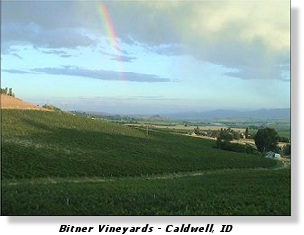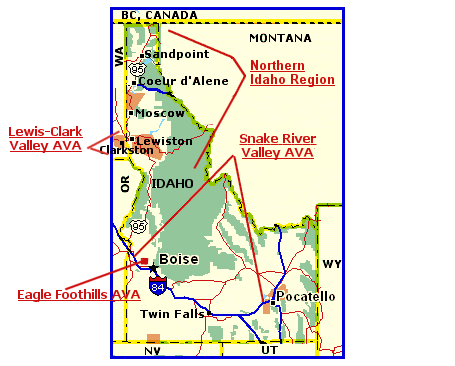|





Winery &
Merchant
Finder



|
|

Idaho
wineries,
wines
and wine
country
|
|
Idaho's vineyard
elevations (ranging up to 3,000 feet) are higher than most others in
the Northwest, and soils are comprised primarily of volcanic-ash.
Add to that long, warm daylight hours during the grape-growing season
(typical of northern latitudes and arid climates), along with cool summer
evenings (characteristic of desert environments), and you have a
combination of factors that contributes to producing quality wine
grapes with concentrated fruit flavors and naturally high acidities. This is the foundation of Idaho's wine industry.
The Snake River Valley became
Idaho's first appellation, authorized by the US Department of the Treasury's
Alcohol and Tobacco Tax and Trade Bureau (TTB) in 2007. The
climatic influence of the Snake
River creates a favorable
growing environment for vinifera grapes, as do other great
rivers in premium winegrowing areas worldwide.
Many of the wineries in Idaho's spectacular north
country (sometimes referred to as the "Panhandle")
source grapes from vineyards located in the Snake River Valley and Eastern
Washington.
In November of 2015, a second Idaho AVA was authorized - the
Eagle Foothills AVA.
Although it lies completely within Snake River Valley AVA
boundaries, Idaho's second AVA's climate and soils are distinct from those of the
larger AVA. Currently (December 2015), nearly 70 vineyard
acres are planted, with plans for more than 450 planted acres in the
near future. The Eagle Foothills AVA encompasses nearly 50,000 acres of
land north of Eagle, Idaho near the state's capital, Boise.
from those of the
larger AVA. Currently (December 2015), nearly 70 vineyard
acres are planted, with plans for more than 450 planted acres in the
near future. The Eagle Foothills AVA encompasses nearly 50,000 acres of
land north of Eagle, Idaho near the state's capital, Boise.
A third Idaho appellation was federally
authorization as of May 2016.
The 306,658 acres that lie within this AVA comprise the
Lewis-Clark Valley AVA.
It include parts of
seven counties in Idaho and Washington and is centered around a
40-mile-long strip of canyons, low plateaus and bench lands formed
by the Snake and Clearwater Rivers with the cities of Lewiston,
Idaho and
Clarkston, Washington nearby. These two towns face each other across
the Snake River and were named in honor of Meriwether Lewis and
William Clark who traveled through the region of this AVA
during their famous expedition of 1803 - 1806. Nestled in a
unique mountainous region of the Bitterroot Mountains - the backbone
of northern Idaho,
the area was a premier wine-grape growing
area in the early 20th Century, an industry that disappeared after
Prohibition. Evidence of the area’s former winemaking
history, including hundreds of acres of abandoned vineyards, can be
found throughout the region. In the early 2000s, wine grapes started
to make a comeback in the area, and today's Lewis-Clark Valley AVA now (as of April 2016) includes
five wineries, 16 grape growers and 81 acres of wine grapes.
|
|
Most Idaho wineries are small, and only a few have a presence on
wine lists of restaurants outside the state... although that number
is growing. Likewise, Idaho wines are somewhat scarce on the
shelves of wine shops outside the local area.
The best and most rewarding
way to access a wide array of Idaho's distinctive wines is
to plan a visit to the winery tasting rooms themselves.
Use the information provided here to create your own custom tour of this
diverse state; explore the expanse and beauty of its lands and
the flavors of its terroir in wines produced from various grape-growing
regions throughout the state. Be sure to take home a few bottles to share with and impress your
friends.
|
|
|
For a complete,
up-to-date list of Idaho wineries and contact information,
visit our
Idaho Winery Finder page for this
state.
Navigating
Idaho Wine Country
|
|
The map and links
below allow you to explore the wines and wineries of each of
Idaho's wine producing areas. You will also find
lodging, dining,
special events and
touring suggestions
organized within these regions for your consideration. Click on the region of your
choice below.




Snake River Valley AVA
- shared with Oregon
Eagle Foothills AVA
- entirely within the Snake River Valley
Lewis-Clark Valley AVA - shared with Washington




Copyright © 1997 -
July, 2020 Susan R. O'Hara.
All rights reserved.
Last revised:
07/31/2020
|
-
-
Idaho
Wine Facts
Number of
Wineries
2019 - 60
wineries
2017 - 55
wineries
2016 - 50
wineries
2010 - 40+ wineries
2008 - 32 wineries
2006 - 23 wineries
2003 - 15 wineries
1998 - 13 wineries
-
Vinifera Acreage
2016 - 1,500
2013 - 1,500
2006 - 1,500
2003 - 1,300
1998 - 820
Major
Varietals Produced
Cabernet Sauvignon, Cabernet Franc, Chardonnay, Chenin
Blanc, Fumé Blanc, Gewürztraminer,
Lemberger, Merlot,
Pinot Gris, Pinot Noir,
Riesling, Sauvignon Blanc,
Semillon, Syrah
Other
Varietals
Malbec, Petite Syrah,
Petite Verdot, Tempranillo,
Tinta Cão, Touriga Nacional,
Touriga Francesa, Zinfandel
Leading Varietals
Chardonnay, Riesling,
Cabernet Sauvignon
Wine
Styles
Still Wines
Sparkling Wines
Fruit Wines & Brandies
Ice Wines & Late-Harvest
Idaho's wine industry
Currently contributes an
estimated $210 million to the
state's economy, a 250%
increase since 2012 when the industry's economic
impact was first calculated.
|
|



